20 Common Floor Plan Mistakes and How to Avoid Them
The definition of a perfect floor plan will vary from one homeowner to another, but some common house plan mistakes can leave you feeling disappointed and frustrated that your dreams fell short.
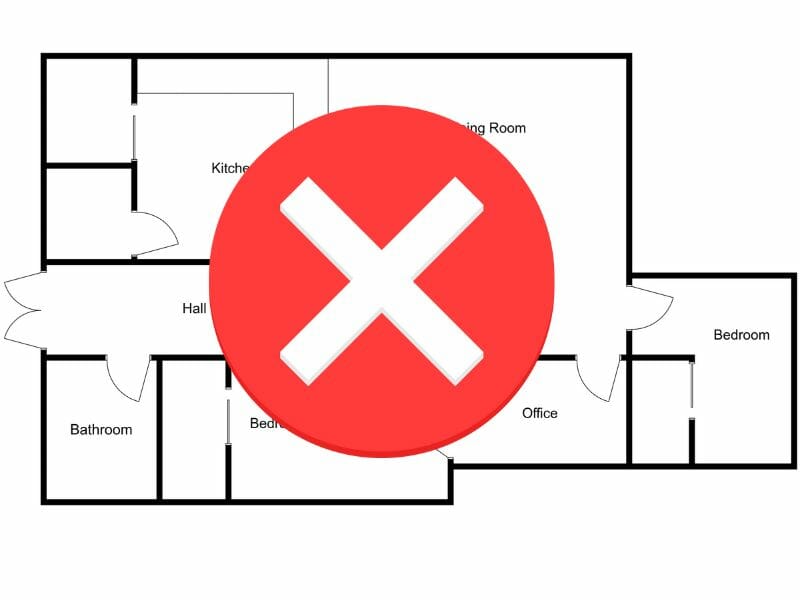
RoomSketcher recently surveyed homeowners about annoying floor plan mistakes. We also reached out to some home and real estate professionals for their tried and true advice we're sure you'll appreciate.
The result: mistakes to avoid, whether you're tackling a new build or embarking on a renovation. If you want to create a home that's as beautiful as it is functional — for today and tomorrow — here are common floor plan mistakes you should steer clear of!
1. Not Knowing Building Codes and Regulations
If you're planning a new construction or remodeling project involving structural or mechanical changes, you must comply with local building codes and permit requirements. Remember, they're designed to ensure your safety and include material standards, installation guidelines, and structural requirements.
Your building code authority might require several sets of drawings for evaluation and approval. Once approved, permit fees will be determined. Some permits may be issued in stages and will depend on a previous stage of completed work. Local inspectors will check all work as your project moves along. The project is considered complete only after final inspection and approval.
PRO TIP:
Keith Sant, Texas Cash House Buyer.
"Contractors need to be aware of building codes and zoning regulations that may apply in certain areas. This can impact the design of the home, as well as its overall safety."
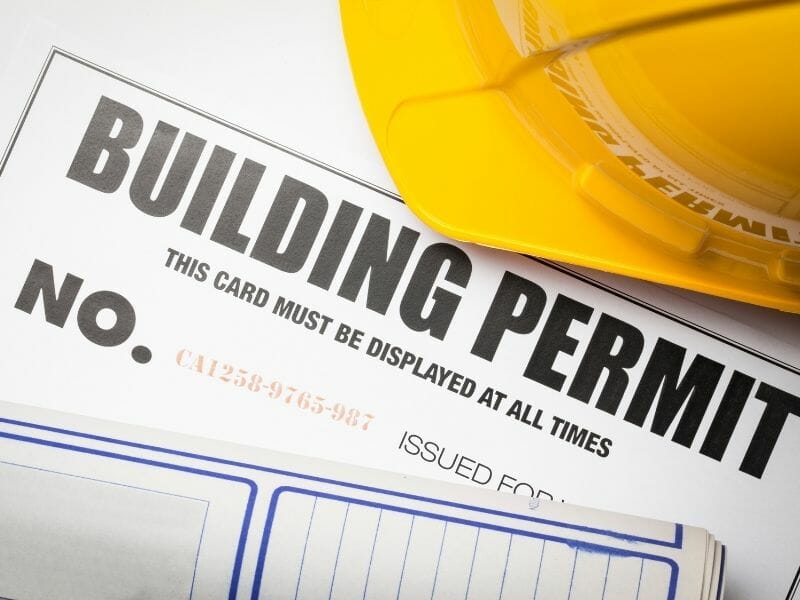
2. Not Establishing and Staying Within a Budget
A realistic budget is the foundation of any successful new build or renovation project. Make a comprehensive list of your must-haves and create a wish list of things you'd like to include if your budget allows. Prioritize each item based on its importance and associated costs. Consider the return on investment. Track your spending throughout the project to avoid going over budget, and always create a contingency fund for unforeseen expenses.
PRO TIP:
Hubert Miles, Home Inspection Insider
"Homeowners planning a remodeling or building project is to start with a clear vision and a realistic budget. They should work with a professional who can help them translate their vision into a functional and aesthetically pleasing space while keeping their budget in mind. Homeowners should also be open to suggestions and willing to compromise on some design aspects to ensure that the final result is practical, functional, and within their budget."
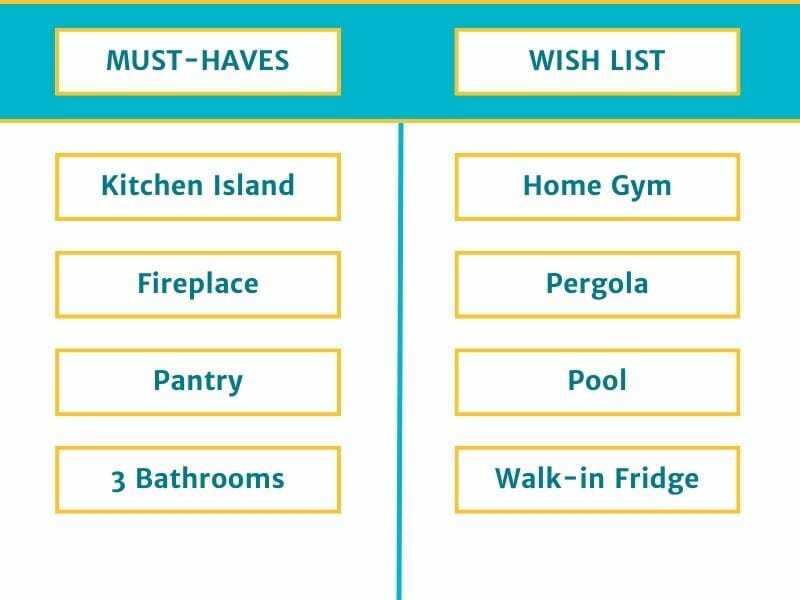
3. Not Considering Current Needs
When planning your layout, there is lots to consider, and while it may be exciting to focus on decorative elements, prioritize your family's current needs and lifestyle. For instance, if you love cooking and entertaining, you might want to set aside a larger space for the kitchen and keep the bedrooms smaller.
PRO TIP:
"Your lifestyle is important because it helps to determine how your layout would work best. Are you OK with a lot of stairs? Do you use the kitchen every day? Are you ever in the living room? Do you need a dining room? Does anyone in your family have accessibility needs?I find some homeowners think they need a lot more space than necessary, and it can be costly to create extra rooms instead of focusing on the areas they use the most. This often leads to unused space and money that could have been spent elsewhere."
Don Rees, CEO & Founder of RealCraft
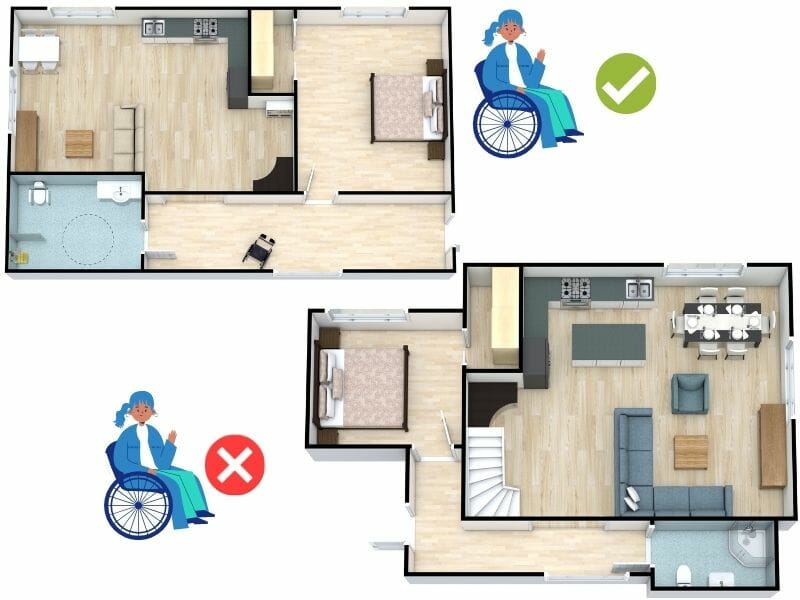
4. Not Considering Future Needs
Many people dream about their forever home and if that's your goal, imagine your future needs when planning your home's layout. That includes ensuring it's versatile and flexible so you can transform the space as your needs change. In fact, 30 percent of RoomSketcher survey respondents concede that not planning their space to fit their future — such as kids, retirement, and pets — is among the three most annoying common floor plan mistakes.
PRO TIP:
Keith Sant, Texas Cash House Buyer.
"Most homes evolve as the needs of a family change. Homeowners should think ahead and plan for possible future changes such as adding a bedroom or bathroom or renovating an area to accommodate a new hobby"
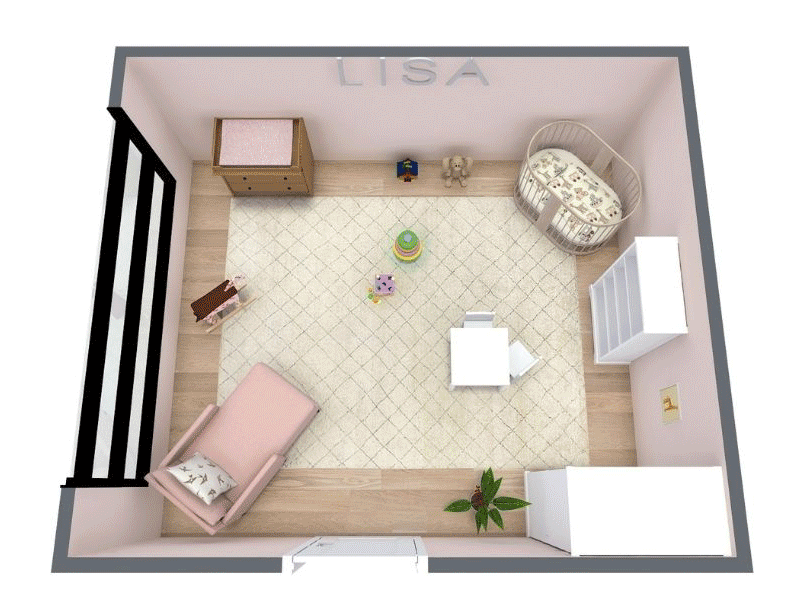
5. Overlooking Zoning and Traffic Flow
Zoning is a design method that groups rooms and outdoor spaces by how we use them to create relationships that positively impact our home's functionality and livability. Pairing bedrooms and a bathroom, for example, is pretty straightforward. Ditto a kitchen that opens to the great room if you like open-concept living. Give extra thought to where you place multifunctional spaces.
Traffic flow, meanwhile, refers to how people flow in and out of a room using entryways and exits. Poor traffic flow can lead to congestion and inefficient use of space. When a space is planned properly, you can travel comfortably in and around the furniture or through the room to another space in the house. As you create a map of connecting rooms, you'll create a comfortable and cohesive space.
When asked to identify the most annoying common floor planning mistakes, 20 percent of RoomSketcher survey respondents say it's placing the dining area far away from the kitchen. Twenty-five percent said the worst floor plan places the home office next to a busy room because it results in too many distractions. On the other hand, 56 percent say they consider natural room placement when planning their layout.
PRO TIP:
Jennifer Spinelli, Founder & CEO of Watson Buys
"When creating a floor plan or room layout, it is essential to take into account the natural flow of the space. This includes providing clear pathways throughout the room, as well as allowing for flexibility in accommodating different activities and furniture pieces."
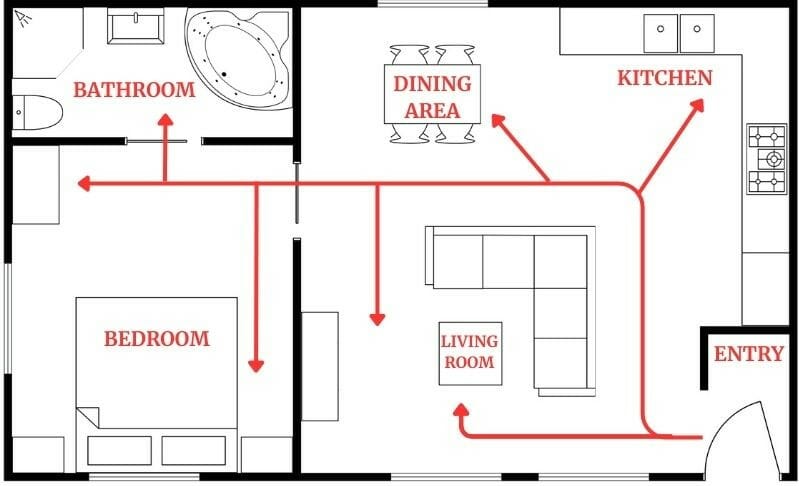
6. Not Paying Attention to Front Entryway
A front entryway or foyer that combines function, comfort, and style can make an inviting first impression. Consider how guests will move around as they step into your home. Pay attention to where they'll hang their coats and ensure the space is well-lit. What focal point will the foyer offer? Will the flooring withstand the elements? Depending on where you live, those elements might include sand, rain, or snow.
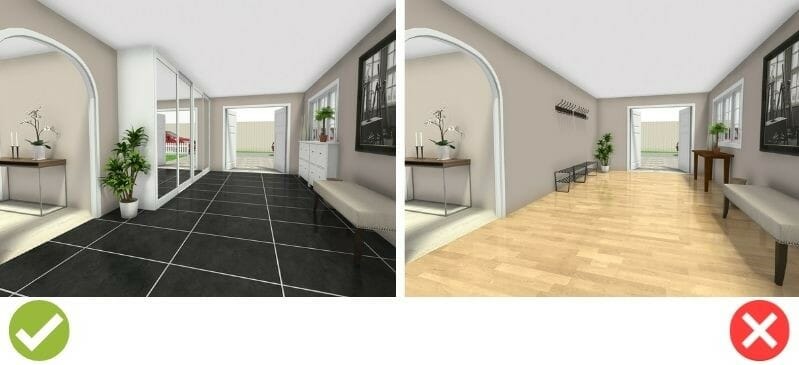
7. Not Taking Advantage of Natural Light
If you spend a considerable amount of time indoors, the benefits of taking advantage of natural light in your home are many and include improving your mood, stimulating productivity, and promoting better sleep.
Natural light can be energy efficient and save money by reducing the need for internal lights. If you have a green thumb, you know your indoor plants need it, too. Perhaps that's why 38 percent of RoomSketcher survey respondents maintain not taking advantage of natural light is among the three most annoying common floor planning mistakes.
PRO TIP:
Daniel Cabrera, Founder of Sell My House Fast.
"If you are looking to ensure a functional and aesthetically pleasing space, the best thing to do is incorporate natural lighting"
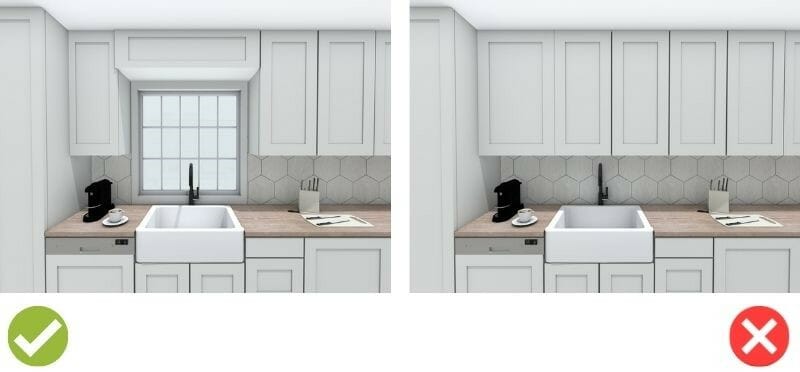
8. Not Considering Furniture and Room Size
Forty-two percent of respondents to our survey listed not considering furniture size as one of the three most annoying common floor planning mistakes. Thirty-five percent believe the size of rooms is the most important thing to consider when creating a floor plan, yet 21 percent admit they'd most likely forget furniture size when planning a layout.
No matter if the space is big or small, the following are some of the things you should consider when placing furniture in a room:
- The size and shape of the room
- Focal points, such as a fireplace
- The location of doors and windows
- Natural lighting
- How the room will be used
- The location of wall outlets
- Traffic flow
PRO TIP:
"A common mistake that homeowners often make is not properly taking into account the size of furniture when deciding on a room layout. This can result in a cramped or awkward space with little to no room for maneuverability or additional pieces of furniture. To avoid this, homeowners should measure their furniture and plan accordingly to ensure the layout is both functional and comfortable."Jennifer Spinelli , Watson Buys
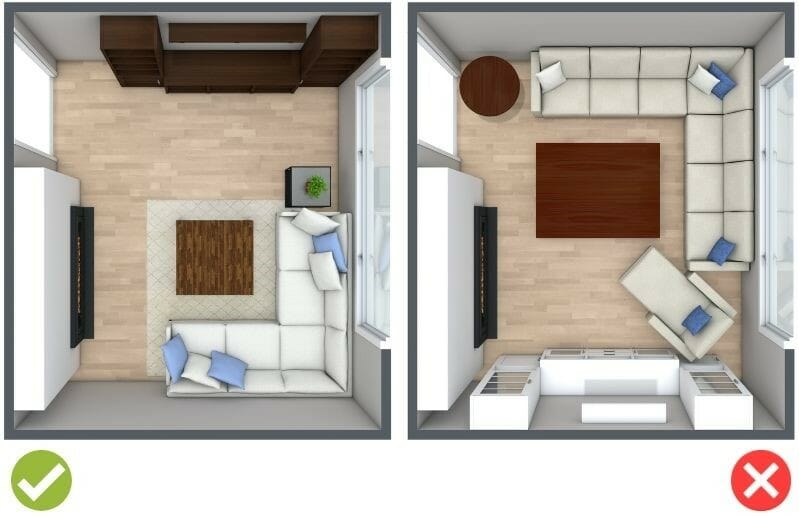
9. Not Enough Storage Space
The importance of efficient storage in a home is often overlooked, but it's crucial to an organized and happy home. It reduces unsightly clutter and ensures you can find what you're looking for when you need it, saving you time and aggravation. Our advice? Overestimate rather than underestimate how much storage space you need.
Respondents to our RoomSketcher survey agree:
- 45 percent said not adding extra storage space is one of the most annoying common floor planning mistakes, while 25 percent said not enough storage in the entry is.
- 31 percent admitted they'd most likely forget enough storage options when planning a layout.
- 54 percent said they'd add some kind of storage — such as a laundry or storage room or pantry — if they could add one room to their floor plan.
- 21 percent said insufficient storage for clothes is the worst floor plan mistake in the primary bedroom.
- 31 percent said not having enough space for proper organization of files and documents is the worst floor plan mistake in a home office.
PRO TIP:
"Homes, especially older ones, often have limited space, which can make creating an effective floor plan tricky. This can also be a challenge when it comes to incorporating storage into the design. I would say a common mistake with floor planning would be forgetting about conveniences such as storage space and closets."Keith Sant, Texas Cash House Buyer
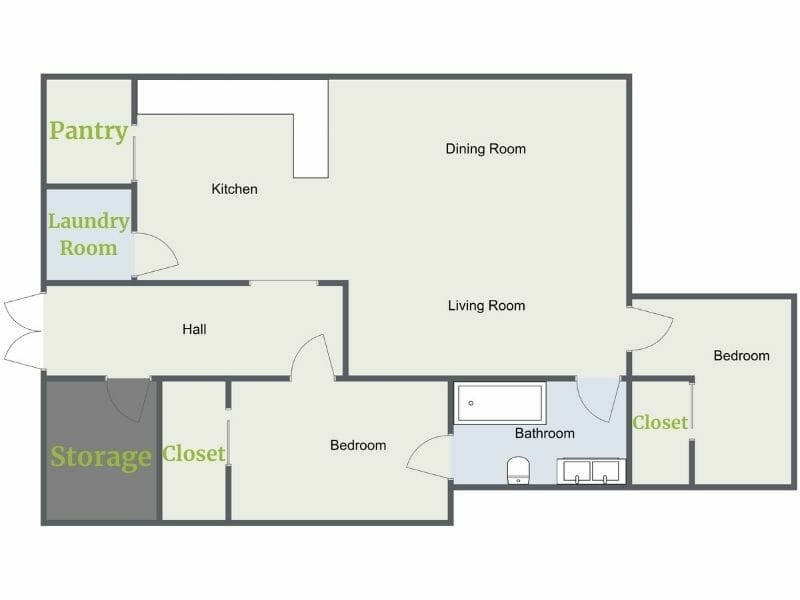
10. Not Considering the Purpose and Functionality of the Space
When planning your home's layout, factor in your family's needs and lifestyle when determining the number of rooms you need and their purpose. If you want your kitchen to be a multipurpose room, for instance, make sure it's a functional space to cook, eat, entertain, work, and learn. If you like shopping in bulk and have a growing collection of mini appliances, additional storage — perhaps in the form of a pantry — is a must.
PRO TIP:
Hubert Miles, Home Inspection Insider
"It is crucial to consider the purpose of each room. For example, a kitchen layout should be designed with the flow of food preparation in mind, while a living room should be arranged to facilitate conversation and relaxation."
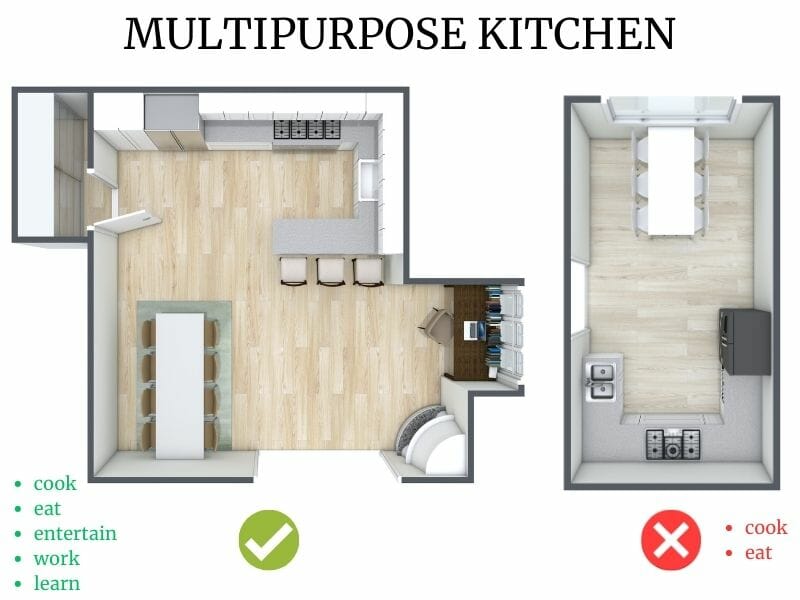
11. Wrong Door Opening Angle
It's important to plan the swing direction of a door in advance and hang it according to plan. Get it wrong and the door becomes an obstacle to entering and leaving a space. Incorrect door swing direction can damage walls and paintwork and make it difficult to place furniture properly.
In fact, 32 percent of RoomSketcher survey respondents listed the wrong opening angle on doors as one of the three most annoying common floor planning mistakes. Another 26 percent admit they'd most likely forget the opening angle and size of doors when planning a layout.
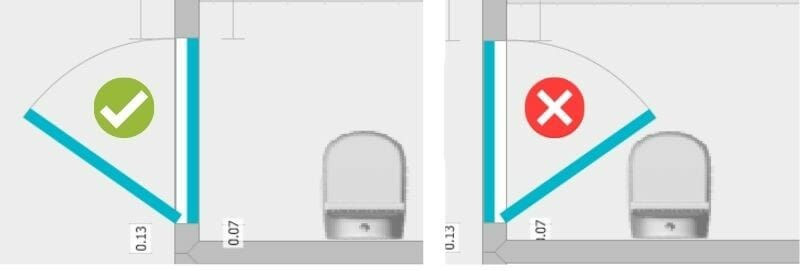
12. Too Few or Misplaced Electrical Sockets
Multi-outlet extension cords can be useful but certainly aren't the solution to a home with too few or misplaced electrical sockets, especially at a time when our homes are filled with countless electronics, many of which need to be plugged in 24/7 or need regular charging.
Though 56 percent of RoomSketcher survey respondents believe insufficient or poorly placed electrical sockets are one of the three most annoying floor planning mistakes, 30 percent confess they'd most likely forget to place electrical sockets when planning a layout.
When determining the location of outlets in your home, make a diagram of every room and think about what you'll likely have in that room, how you plan to place the furniture, and how you want to use the space. Then place your outlets on the diagram accordingly. Consider an outlet on a kitchen island, an outlet for a mounted TV, as well as outlets in the garage.
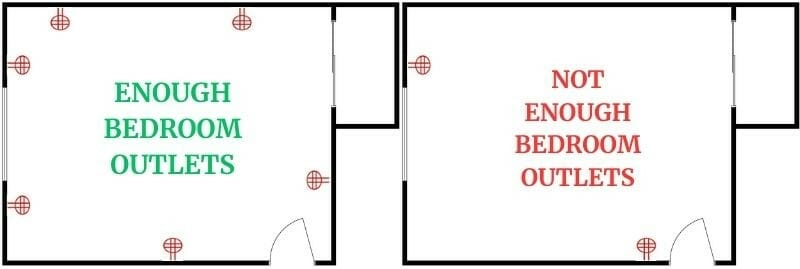
13. Not Considering the Acoustics and Noise Separation
If you're a fan of home improvement shows, you've probably seen your share of demo days when crews tear down walls to create an open-concept floor plan, transforming the main floor into one big space. But as many families discovered while working and learning at home during the pandemic, privacy can be a great thing, too.
As a result, many are embracing floor plans that provide privacy for spaces like a home office, music room, or gym. If that's to your liking, don't overlook acoustics and noise separation. According to our survey, 35 percent of respondents admit they'd most likely forget those things when planning a layout. Still, you can dampen unwanted household noises through architecture or furniture placement.

14. Not Paying Attention to Measurements
There's a good reason carpenters often say, “Measure twice, cut once.” It means you should double-check your measurements for accuracy before cutting a piece of wood. Otherwise, you may need to cut again, wasting time, materials, and money.
Twenty-one percent of our survey respondents admit they'd likely neglect the dimensions of the floor plan when planning a layout. RoomSketcher encourages you to apply that popular carpenter's expression to your home, whether you're measuring for appliances, cabinetry, furniture, paint, wallpaper, or any of the countless other things that help bring your dreams to life.
PRO TIP:
Thomas Borcherding, HomeStar Design Remodel and Artisan Kitchen & Bath
"Oftentimes, homeowners don't double or triple check their measurements. If you're going to be ordering tens of thousands of dollars worth of materials, you want to make sure that they fit. It's very important to capture the room's ceiling height and to measure not just from one part of the wall, but from the bottom, middle, and top of the wall."

15. Not Considering the Outdoor Space
Regardless of size, an outdoor living space is an important extension of your home. Imagine how you'd like to use the space and consider dividing it into zones, such as dining, entertaining, relaxing, and playing to meet your family's needs.
Though 46 percent of RoomSketcher survey respondents consider the indoor and outdoor space as a whole when planning their layout, 18 percent admit they'd most likely forget to do so when planning their layout. That represents a missed opportunity to create an outdoor oasis to decompress at the end of a long day.

16. Not Planning Furniture Arrangement Before Purchasing Furniture
You walk into a furniture store and fall in love with an oversized sectional that comfortably accommodates your entire family and even your pampered pooch on movie nights. Before you know it, you're choosing the fabric.
Unless you've planned out your furniture arrangement in advance, take a step back and do your homework. Determine if it will fit properly and allow for side tables and other accessories. Pick a focal point, consider traffic flow, consider scale and proportion, and make sure the space has room to breathe.
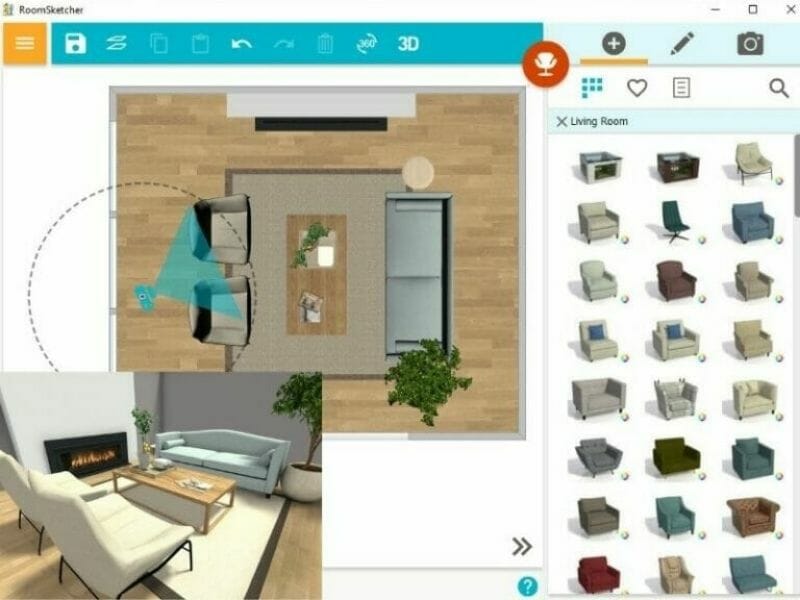
17. Not Considering Lines of Sight
Lines of sight — the hypothetical lines from your eye to what you can see in front of you — matter, but 22 percent of RoomSketcher survey respondents reveal they'd most likely forget about them when planning a layout.
A layout that creates a view from one space through another and then to the outdoors, for instance, can feel larger than it is. In a kitchen and family room design, good sightlines allow you to keep your eye on the kids and watch TV while preparing dinner. Lower furniture or rearranging furniture can help create clean sight lines.
Some sightlines should be avoided, either because they're simply unappealing or because you appreciate privacy. Think sightlines that allow you to see dirty dishes piled in the kitchen sink or the toilet when the bathroom door opens.
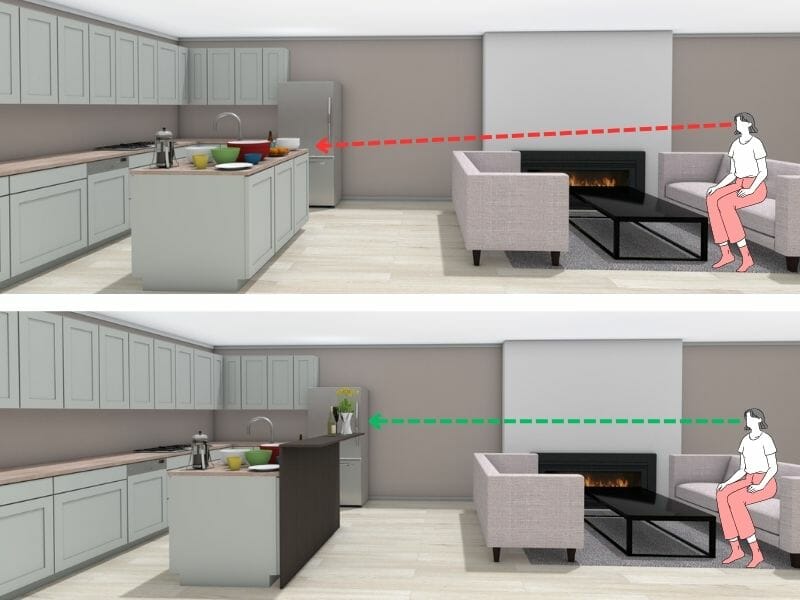
18. No Privacy Zones
No matter how much you love your family, we all crave privacy at times, but it's not always top of mind, especially in open-concept layouts. Twenty percent of RoomSketcher survey respondents say they'd likely forget privacy — especially in bathrooms — when planning a layout.
Bedrooms and bathrooms in particular, merit privacy, and that can be created through layout and furniture placement. Avoid placing the door to your primary bedroom in your main living area by adding a small hallway that ensures the bedroom entry is out of sight, for example. Likewise, the door to your main floor powder room. You might also want to create privacy in an informal entry or mudroom where your family drops off all their belongings.
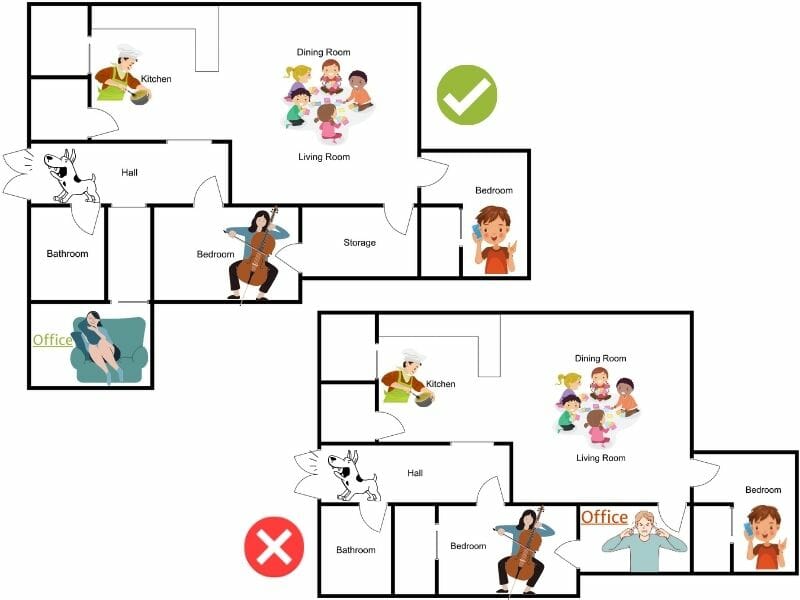
19. Wrong Window Placement
A house with natural light feels brighter and more open and spacious, so proper window placement is key. Our tips for planning window placement in your home include thinking about how much light you want in a space, comfort and privacy, views, and the proportion of glass to the wall.
Don't forget about the little rooms. A window in a powder room, mudroom, or laundry room can brighten and expand the space while also allowing for fresh air. Pay attention to light reflection. Twenty-two percent of our survey respondents say that poor placement of the TV and windows is the worst living room floor plan mistake because it results in annoying light reflection on the TV screen.
PRO TIP:
"One of the most common mistakes I've seen homeowners make when planning a floor layout is just not to consider how all the elements of the layout will work together to create an atmosphere.One thing that often gets forgotten is window placement, both for natural light and airflow. You might not even consider that where you place windows can affect the overall feel of your finished home. They really do have a huge effect on not only how much light your home receives but on how hot certain rooms get during the summer."
Andre Kazimierski, Founder and CEO of Improovy

20. Creating a Floor Plan That is Too Big or Too Small
Bigger is not necessarily better when it comes to creating a floor plan. A large home is more expensive to build, decorate, and maintain and can feel unwelcoming if you don't need the space. And though it's often been said that 'good things come in small packages,' that's not necessarily true if your home feels like it's bursting at the seams. Striking the right balance is key.
PRO TIP:
Todd Saunders, CEO of FlooringStores
"One mistake you'll want to avoid when floor planning is allocating space incorrectly. Pay close attention to dimensions to ensure you aren't accidentally planning, for instance, overly large bathrooms or too small bedrooms. Keeping the purpose of each room in mind while designing your layout will help you ensure that space is used in the best way possible."
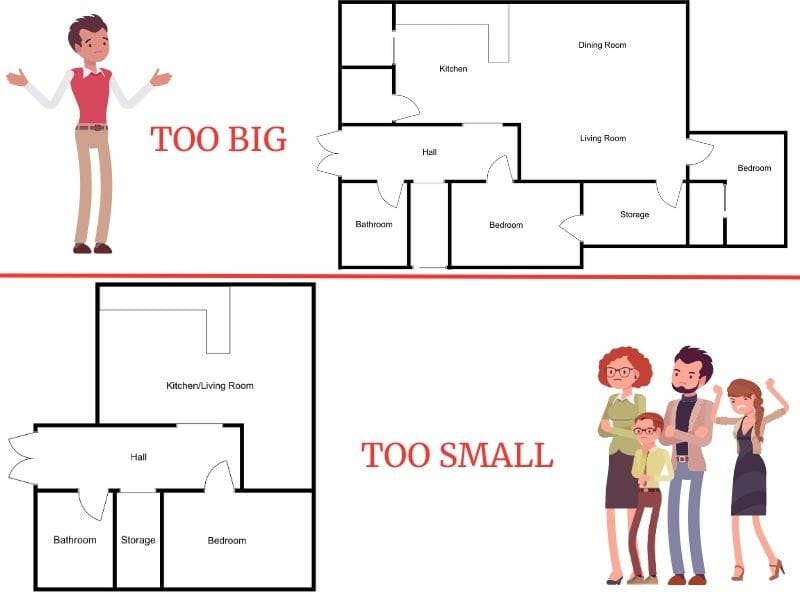
Save Time — Plan Online
With RoomSketcher floor planner software, you can create your house plan or room layouts in no time. Draw walls, add windows, doors, and stairs, and add in your furniture. Plan your traffic flow, place your electrical outlets, and check your door angles. With the interactive, drag-and-drop software, you can move around and change your layout until you are 100% satisfied and avoid all the common floor plan mistakes.
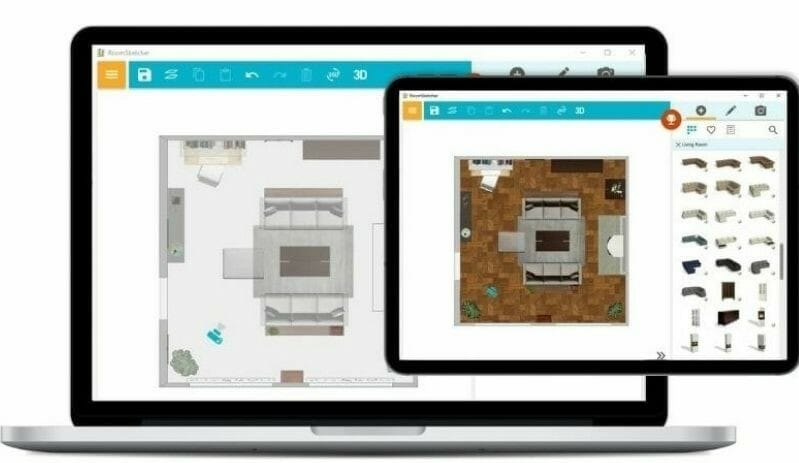
Get started for free, then upgrade for more powerful features.
Don't forget to share this post!
Recommended Reads
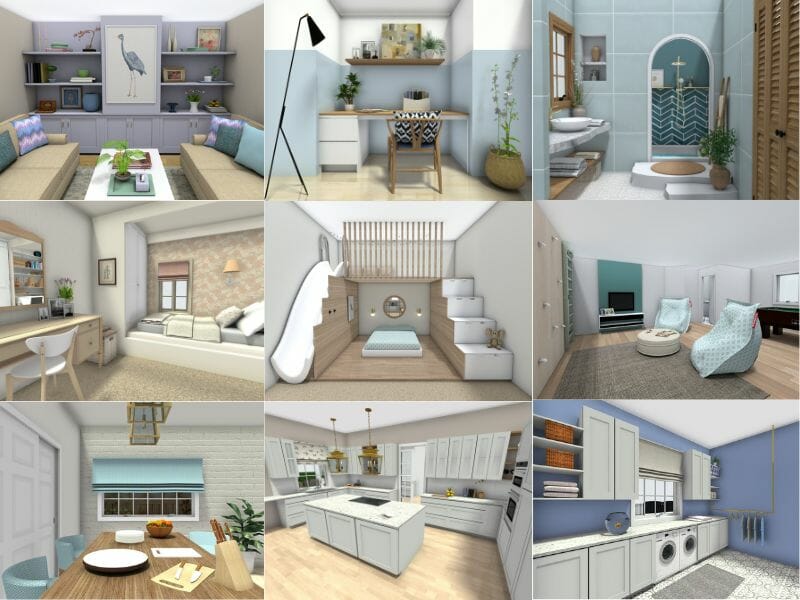
54 Rooms in a House: Design Inspiration for Every Corner of Your Home
Your home is a sanctuary that reflects your personality and caters to your needs. It's a collection of rooms serving a unique purpose and contributing to your living environment's overall functionality and comfort. Explore their unique purposes and design possibilities today.
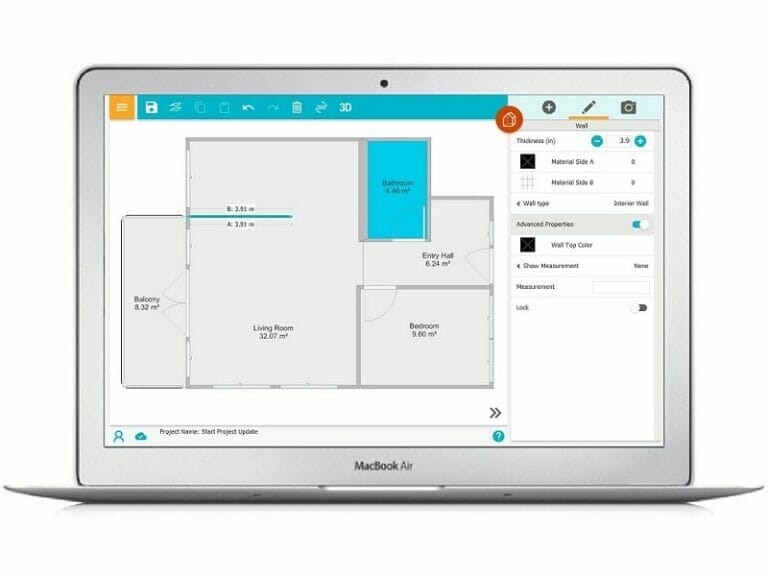
Why RoomSketcher Is the Best Floor Plan Tool Out There
After careful research, we highly recommend RoomSketcher as the best floor plan tool available. Learn the reasons why RoomSketcher stands out.
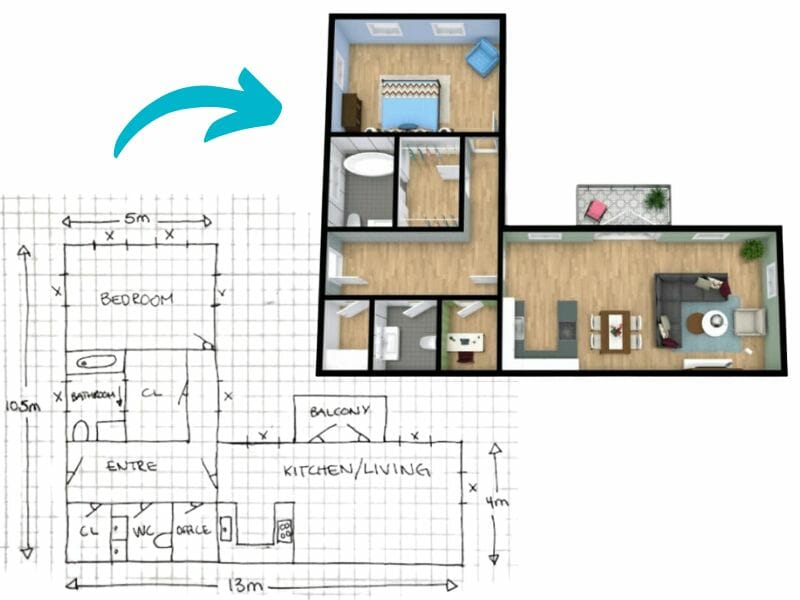
From Sketch to Reality: How to Design a House You'll Love
We give you useful steps on how to design a house yourself. Discover the key steps to designing a house that perfectly fits your needs.
